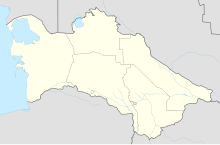Namazgadepe
Coordinates: 37 ° 22 '22.3 " N , 59 ° 33'25.1" E
Namazgadepe (also Namazga Depe , Namazga Tepe or Namasga Tepe ) is one of the oldest archaeological sites in Central Asia , along with Jeitun . The 70 hectare Tepe (hill) is located 80 kilometers southeast of Ashgabat in Turkmenistan near the Iranian border and is considered to be an important testimony to early agriculture in the region. Phases I-VI can be distinguished in Namazgadepe.
In Namazgadepe, estuary areas were regulated by means of Liman irrigation and used for grain cultivation. In the course of the development of this culture there were technical innovations, such as the use of carts and wagons to use cattle as draft animals and the use of the potter's wheel . Finds show ties to Sarasm in Tajikistan, Iran, Afghanistan and the Harappa culture .
The oldest layers of settlement are assigned to the Chalcolithic . In Namazga I, contacts to Tappe Sialk and other cultures in the region can be proven. Namazga II is between 5300 and 4300 BC. During phase III, changes in the burial ritual, in the ceramic design and in particular in the shape of the skull indicate immigration. In the Bronze Age layers (Namazga IV and V, 2400–1700 BC) one finds evidence of metal use. Copper was already known in Namazga I , but the three early phases were rural village cultures whose technological knowledge was constantly advancing. From Namazga IV, potter's wheels were used and the settlements were fortified by a mud brick wall and were significantly larger. Layer five features multi-room adobe houses with alleys, clay two- and four-wheel wagon models and bronze tools.
A distinction is made between several styles of colored ceramics , which were produced on the potter's wheel and fired in two-story round, rounded and angular kilns. The ovens, some of which were very complex, had cantilever vaults made of dry stone . Only the lower fire chambers of the pottery kilns, which also contained central pillars or partition walls, were preserved. The inner diameters of the round ovens are between one and 2.25 meters. The dimensions of the walls are between 0.3 and 0.45 m.
Some clay figures from Karadepe are similar to those of the Obed period (Ubaid culture) of Mesopotamia . Clay and stone seals were found. The variously rich gifts of the dead suggest a social hierarchy. Figures of mother goddesses provide information about the religious ideas in Namazgadepe.
The first excavations took place in the 1950s. The site is important for establishing a Bronze Age chronology for the region. Turkmenistan was on the threshold of the Bronze Age civilization , but remained a peripheral area.
See also
literature
- Grégoire Frumkin: Archeology in Soviet Central Asia . Leiden: EJ Brill, 1970. pp. 133-140.
- Fredrik Talmage Hiebert, Kakamurad Kurbansakhatov, Hubert Schmidt: A Central Asian village at the dawn of civilization, excavations at Anau, Turkmenistan . Philadelphia: University of Pennsylvania Museum of Archeology and Anthropology, 2004. pp. 19-23.
- Vadim Mikhaĭlovich Masson, Viktor I. Sarianidi: Central Asia: Turkmenia before the Achaemenids . In: American Anthropologist (1973). Pp. 1945-1948.
Web links
- Marion Linska, Andrea Handl, Gabriele Rasuly-Paleczek: Introduction to the ethnology of Central Asia. ( Memento from September 9, 2006 in the Internet Archive ) (PDF; 619 kB; 129 pages) Lecture notes, Vienna January 2003, from p. 52 f (accessed on June 16, 2013)
- Article Namazgadepe in the Great Soviet Encyclopedia (BSE) , 3rd edition 1969–1978 (Russian)
